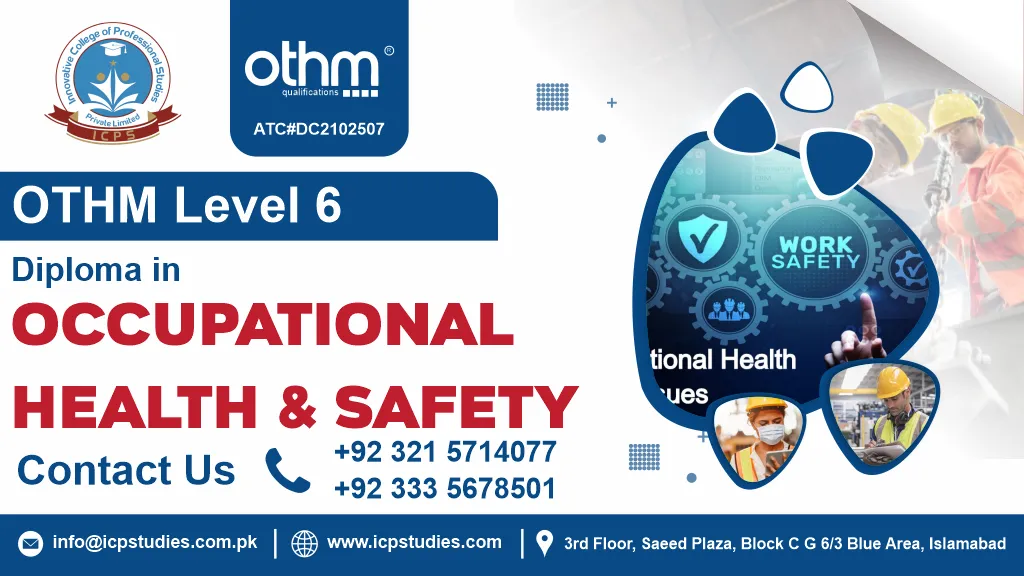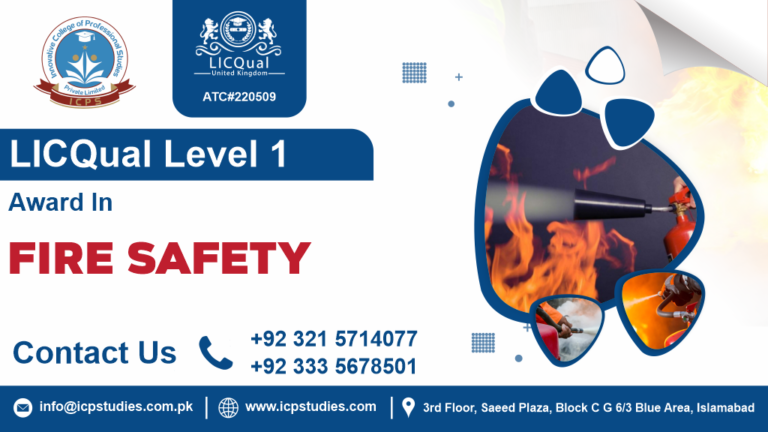Become eligible to apply for Graduate level of membership Grad IOSH
In today’s fast-paced and ever-changing workplace environment, the importance of Occupational Health and Safety cannot be overstated. Ensuring the health, safety, and well-being of employees is essential for any organization, and for professionals aspiring to excel in this field, the Diploma in Occupational Health and Safety is the key to unlocking a rewarding career. This Ofqual-regulated, UK-based qualification provides in-depth knowledge and practical skills, allowing you to manage health and safety risks and promote a culture of safety in diverse workplaces.
OTHM Level 6 Diploma in Occupational Health and Safety is a UK Ofqual-regulated certification designed for individuals seeking to enhance their expertise in health and safety management. The course provides a practical, assignment-based learning approach, allowing learners to gain real-world knowledge and skills that can be immediately applied in the workplace.
With the OTHM Level 6 Diploma in Occupational Health and Safety, you’ll be well on your way to a rewarding and fulfilling career in workplace safety. Don’t wait – enroll today and take the first step towards a safer, healthier, and more productive workplace for everyone.
Innovative College of Professional Studies (Private) Limited is approved training centre of Organisation for Tourism and Hospitality Management (OTHM). ICPS OTHM ATC Number is DC2102507
All About OTHM Level 6 Diploma in Occupational Health and Safety
Course Overview
The Diploma in Occupational Health and Safety is a comprehensive Ofqual-regulated qualification designed to provide professionals with a solid understanding of the principles and practices needed to ensure workplace safety. This UK-based certification is recognized worldwide, making it a highly regarded qualification for individuals looking to pursue careers in health and safety management across various industries.
OTHM Level 6 Diploma in Occupational Health and Safety focuses on essential topics such as risk assessment, safety legislation, health and safety management systems, and hazard identification. With assignment-based assessments, the qualification is tailored for learners to apply their knowledge directly to real-world scenarios, helping to cultivate practical skills that are necessary to protect employees and organizations from health and safety risks.
OTHM Level 6 Diploma in Occupational Health and Safety is ideal for those already working in or seeking to enter the health and safety sector, as well as for current professionals who wish to formalize their expertise and advance in their careers.
Key Takeaways
he entry requirements for the OTHM Level 6 Diploma in Occupational Health and Safety typically include:
- Educational Background:
- A relevant Level 5 qualification in Occupational Health and Safety or a related field.
- Alternatively, candidates may hold a bachelor’s degree in a relevant discipline.
- Professional Experience:
- A minimum of two years of work experience in occupational health and safety or a related area is usually recommended.
- English Language Proficiency:
- Proficiency in English (both written and spoken) is required. Non-native speakers may need to provide evidence of their language skills (e.g., an IELTS score of 6.0 or equivalent).
- Motivation Statement:
- A statement outlining the applicant’s interest in occupational health and safety and how the course will benefit their professional development may be encouraged.
- Additional Qualifications:
- Relevant professional certifications (e.g., NEBOSH, IOSH) may strengthen the application but are not mandatory.
For the most accurate and specific information, it is advisable to consult the specific institution or provider offering the OTHM Level 6 Diploma in Occupational Health and Safety.
Mandatory Units
Learning Outcomes
The learning outcomes for the OTHM Level 6 Diploma in Occupational Health and Safety are as follows:
1. Health and Safety Management Principles and Policy
- Understand the fundamental principles of health and safety management within organizations, including risk assessment, hazard control, and compliance strategies.
- Develop knowledge of the key components of health and safety policies, their objectives, and their importance in ensuring workplace safety and regulatory compliance.
- Evaluate the roles and responsibilities of management, supervisors, and employees in implementing effective health and safety strategies and promoting a safety-first culture.
- Analyze the alignment between organizational goals, operational processes, and health and safety policy frameworks to ensure integrated risk management.
- Examine international, national, and industry-specific standards, regulations, and guidelines that govern health and safety management systems (OHSMS).
2. Health and Safety Management Practice
- Apply practical strategies to implement effective health and safety management systems in the workplace.
- Develop and document procedures to control workplace hazards, maintain compliance, and enhance overall occupational health and safety performance.
- Monitor and review operational health and safety practices to identify gaps, implement corrective measures, and ensure continuous improvement.
- Coordinate with cross-functional teams to ensure adherence to health and safety procedures and best practices across all organizational levels.
- Demonstrate effective communication and leadership skills in conveying health and safety instructions, protocols, and emergency procedures to employees.
3. Risk and Incident Management
- Conduct comprehensive workplace risk assessments to identify potential hazards and evaluate their impact on employees and operations.
- Prioritize risks using established methodologies and implement mitigation strategies to reduce workplace accidents and incidents.
- Develop and enforce control measures to prevent incidents, injuries, and occupational illnesses in line with health and safety legislation.
- Investigate workplace incidents, accidents, and near-misses to determine root causes and prevent recurrence.
- Record, report, and analyze incidents accurately to comply with regulatory requirements and enhance the effectiveness of the organization’s health and safety management system.
4. Promoting a Positive Health and Safety Culture
- Understand the concept of organizational culture and its direct impact on workplace safety, employee engagement, and risk awareness.
- Implement strategies to encourage employee participation in health and safety initiatives, including training, workshops, and safety campaigns.
- Promote proactive behavior, continuous improvement, and safety-first practices in everyday workplace operations.
- Recognize the role of leadership in modeling and reinforcing a positive health and safety culture at all levels of the organization.
- Develop programs to raise awareness, educate staff on health and safety policies, and embed safe working practices throughout the organization.
5. Maintaining a Safe Workplace Environment
- Identify and assess workplace hazards associated with physical, chemical, biological, and ergonomic factors affecting employee health.
- Implement control measures, safe working procedures, and risk reduction strategies to maintain a secure and healthy work environment.
- Conduct regular inspections, audits, and workplace evaluations to ensure compliance with occupational health and safety standards.
- Encourage employee participation in safety programs, hazard reporting, and ongoing workplace safety initiatives.
- Evaluate the effectiveness of safety measures, recommend improvements, and ensure the continuous enhancement of health and safety management systems.
6. Health and Safety Law, Regulation and Influence
- Understand key health and safety legislation, statutory obligations, and regulatory frameworks applicable to different industries and work environments.
- Examine how legal requirements and regulations influence workplace safety practices and organizational compliance strategies.
- Evaluate the role of industry standards, codes of practice, and guidance in shaping health and safety procedures and policies.
- Interpret legal requirements to develop and implement compliant health and safety policies, risk assessments, and operational procedures.
- Assess the role of regulators, enforcement bodies, and professional organizations in promoting compliance and advancing workplace safety culture.
7. Development of the Health and Safety Practitioner
- Develop the professional knowledge, skills, and competencies required to excel as a health and safety practitioner in diverse work environments.
- Understand the ethical, legal, and professional responsibilities of occupational health and safety practitioners.
- Engage in continuous professional development to stay current with emerging health and safety trends, technologies, and regulatory changes.
- Apply strategic thinking and problem-solving skills to address complex workplace safety challenges and risk management issues.
- Demonstrate leadership, influence, and advocacy in promoting health and safety excellence and embedding a proactive safety culture across organizations.
The OTHM Level 6 Diploma in Occupational Health and Safety is designed for:
- Health and Safety Managers: Professionals responsible for developing and implementing health and safety policies within organizations.
- Safety Officers: Individuals tasked with monitoring workplace safety and compliance with regulations.
- Risk Managers: Professionals focused on identifying and mitigating health and safety risks in the workplace.
- Compliance Officers: Individuals ensuring adherence to health and safety laws and regulations.
- HR Professionals: Those involved in employee welfare and health and safety management.
- Occupational Health Practitioners: Individuals seeking to enhance their knowledge and skills in health and safety management.
- Team Leaders and Supervisors: Managers who need to understand health and safety responsibilities to effectively lead their teams.
- Consultants: Those providing advice on health and safety practices within various organizations.
Overall, the course targets individuals committed to advancing their knowledge and skills in occupational health and safety management, preparing them for leadership roles in this field.
Successful completion of Level 6 Occupational Health and Safety qualifications provides learners with the knowledge, understanding, and skills to be competent in a range of Occupational Health and Safety roles. Individuals who achieve the diploma qualification will be eligible to apply for Certified level of membership CertIOSH.
Those eligible for Certified membership can then undertake a period of Initial Professional Development which will require students to provide evidence of their practice skills in a skills development portfolio (IPD). At the end of this period, there will be a professional review interview. After successful completion of this IPD process, students will then be eligible for Chartered membership of IOSH (CMIOSH).
FAQs Related to OTHM Level 6 Diploma in Occupational Health and Safety







